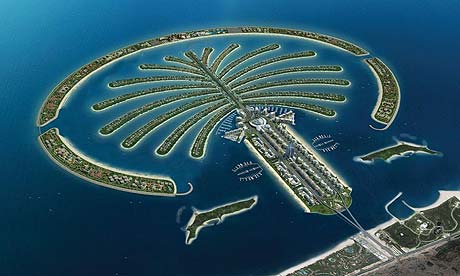
One of the things people in other countries often ask one about Dubai is the Palm. Not all know that there is more than one, but the concept is certainly famous enough that people are curious. While parts of it are nice, there are less-appealing aspects, including the questionable environmental impact and less than fully reliable real estate arrangements. Add rumors of sinking sections causing damage, the fact that even palm Jumeirah is still a construction site (we rented a place out there a few months ago when some of my elephant polo team met up in town en route to a tournament, and our apartment door was labeled"occupied" to distinguish it from all the rest. I went swimming with the dear sister, and felt more than a little guilty swimming under the gaze of the near-by construction workers. The trunk road is also a pain; in order to minimize traffic, it is all one-way. If your place is on the left side of the trunk as you enter, you must drive down it to turn around to et to your building. This gets old. Even the larger, more expensive villas are pretty close to one another as well, making privacy difficult), my own concerns about traffic (the trunk connects to the road at one point, one future serious traffic choke point), rumors of sharks out near the end fronds (there are sharks in the Gulf, but far out. But the Palm is far out) and the general kitchiness question.
Now the mainstream press, often so positive (with the exception of some articles devoted to the plight of laborers and domestics) is starting to notice as well. The Guardian ran an article titled "Pitfalls in Paradise: Why Palm Jumeirah is Struggling to Live Up to the Hype," first brought to my attention by Grape Shisha.
To be fair, only roughly 4,000 people of the 65,000 who will eventually live there (plus the 40-odd hotels) have already moved in, so you can't say that the Jumeirah Palm is "done," so some of these issues may be fixed in the future. But some may also be exacerbated.
Among the issues detailed by the Guardian:
- Multimillion-pound villas squeezed together "like Coronation Street" (a British soap opera including a street of that name, full of tight houses). This is also apparently the result of deceptive construction practices ala the metro line. The article quotes Rachael Wilds, 42, an exhibition organiser from Surrey who moved in with her family to a palatial villa on one of the Palm's "fronds" a year ago, who complained that she found her £3m property squashed against a neighbour's and set in a barren, almost treeless, landscape. "It was absolutely nothing as it was depicted in the brochure," she says. "There was a massive gap between the villas and it was full of lush tropical gardens. We were totally shocked at the closeness of the villas." What is true elsewhere is doubly true in Dubai. Caveat Emptor.
- Air-conditioning bills of £800 a month (roughly 1600 USD). This is just poor engineering. Its not like the weather would be a surprise. Could they not make the houses more efficient? This is also the buyers' fault too though - they should have paid attention to such things.
- Overly-pushy PR. The villas were built by state-owned Nakheel Properties, and their is omnipresent on flags all over the island. For some residents, this is a little much. Again to be fair though, flags with logos and slogans are all over Dubai, especially along bridges and main roads. So complaining that the Palm is doing this may also fall under the "well, what did you expect" rubric.
- Intensive irrigation is necessary to maintain the landscaping, but uses tremendous amounts of water (note: most of the water will come from desalinization plants, which themselves use tremendous amounts of energy)
- Tallest trees actually mobile phone masts dressed up to look like palms (I didn't notice these, so they must be at least OK. There is one across from the entrance to Madinat though and it isn't bad for what it is)
- Guilt over the quality of life of the migrant construction workers. This is a real concern. But again, this is a pan-Dubai issue and one people should consider when purchasing anywhere here. Problems mentioned in the Guardian include low salaries of 200 USD per month, debts to agents in their home countries who paid for their passage with interest rates as high as 120% a year, increasing alcoholism and debts accumulated to pay for said drink, unpaid salaries, poor living conditions, rising suicide rates and separation from families at home.
13m: The number of liters of desalinated drinking water the Palm Jumeirah uses when at capacity (they didn't say in what period. It may in one day).
28: Bottlenose dolphins have been flown in from the Solomon Islands to populate Dolphin Bay, an 11-acre lagoon
94m: The cubic meters of sand used to build the Palm Jumeirah
84: The site has doubled the natural 42-mile coastline of Dubai
4: The Palm is four times the size of Hyde Park in central London

No comments:
Post a Comment